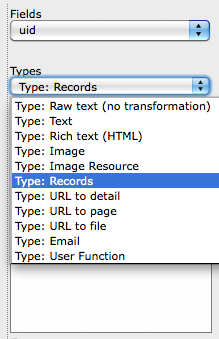DEPRECATION WARNING
This documentation is not using the current rendering mechanism and is probably outdated. The extension maintainer should switch to the new system. Details on how to use the rendering mechanism can be found here.
Element types¶
There are various element types that can be chosen according to your needs:

Selecting an element type in the mapping interface
The various element types are described below. For each one you will find its type, a description and a link to the related TypoScript object or function used for rendering. The links point to the TypoScript Reference.
Raw text¶
- Type
- Raw text
- Description
- This will display the data from the database field as is, without any transformation. Use this whenever possible, as it gives much better performance.
- TypoScript Object / function
Text¶
- Type
- Text
- Description
- The local TypoScript is the same as for Object TEXT. The value of the TEXT object will be loaded with the value from the mapped database field.
- TypoScript Object / function
- TEXT
Rich text¶
- Type
- Rich text
- Description
- This is actually the same as the “Text”-type element, but it is designed to handle fields that use the RTE. Such fields need special rendering, so that RTE data is interpreted before display in the front-end. As this is not necessary with every text field, a separate element type exists.
- TypoScript Object / function
- TEXT
Image¶
- Type
- Image
- Description
- The value from the database field will be automatically stored in the “file” property of the object.
- TypoScript Object / function
- IMAGE
- Default parameters
altText = file\_name titleText = file\_name
Image Resource¶
- Type
- Image Resource
- Description
- Returns only the image-reference, possibly wrapped with stdWrap. The value from the database field will be automatically stored in the “file” property of the object.
- TypoScript Object / function
- IMG_RESOURCE
Media¶
- Type
- Media
- Description
- Uses the MEDIA content object for rendering, so it can be used for displaying video or audio files. The value from the database field is used automatically for the "file" property.
- TypoScript Object / function
- MEDIA
- Default parameters
type = video renderType = auto
FAL references¶
- Type
- FAL references
- Description
- Used for rendering data related to FAL, be it references, collections or folders, anything that can be handled by the FILES content object.
- TypoScript Object / function
- FILES
Records¶
- Type
- Records
- Description
- Will render records using the TypoScript RECORDS object. The value is expected to be a uid or have the structure "tablename_uid" (e.g. tt_content_38). The mapped value is automatically stored in the "source" property of the object.
- TypoScript Object / function
- RECORDS
URL to detail¶
- Type
- URL to detail
- Description
This is designed to create a link and corresponds to the typolink TS function. It is automatically loaded with a configuration to create a link to a detail view as expected by the Display Controller (extension: displaycontroller). It is also configured to return only the URL, but this can be overridden in the local TS.
The value from the database field will be automatically stored in the “additionalParams” property of the object.
- TypoScript Object / function
- typolink
- Default parameters
useCacheHash = 1 returnLast = url additionalParams = &tx\_displaycontroller[table]=xyz&tx\_displaycontrolle[showUid]=$value
URL to page¶
- Type
- URL to page
- Description
- It should be used only for database fields who contain page id's, as it will create a link to said page. The value from the database field will be automatically stored in the “parameter” property of the object.
- TypoScript Object / function
- typolink
- Default parameters
returnLast = url useCacheHash = 1
URL to file¶
- Type
- URL to file
- Description
- Meant for links to files. The value from the database field will be automatically stored in the “parameter” property of the object.
- TypoScript Object / function
- typolink
- Default parameters
returnLast = url useCacheHash = 1
Email¶
- Type
- Description
- Meant for emails. The value from the database field will be automatically stored in the “parameter” property of the object.
- TypoScript Object / function
- typolink
User function¶
- Type
- User function
- Description
It is preconfigured with a property called “parameter” which will contain the value from the database field. The value from the database field will be automatically stored in the “parameter” property of the object.
Additionally, since version 1.8.0, user functions have a property called
additionalParameterswhich is used to pass more parameters to the user function. All items in theadditionalParametershave stdWrap capabilities. In particular, this makes it possible to pass data from the record currently being handled.Example:
additionalParameters { currentId.field = uid currentRequest.data = gp:foo }
Considering the above configuration with the current record having a uid of 42 and the GET/POST variable a value of "bar", the following would be available inside the user function:
$configuration['additionalParameters.']['currentId'] = 42; $configuration['additionalParameters.']['currentRequest'] = 'bar';
- TypoScript Object / function
- USER